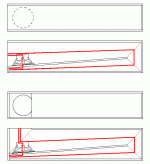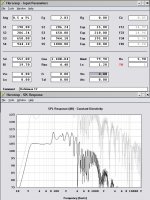Chris - Thanks for the pix. It makes our efforts worthwile. Plywood is pretty, but expensive and too resonant. OSB and Wafer board are "dead" which is a good thing for speaker cabinets. What is the name of the stuff you used? How expensive is it? Is it heavy?
Mashaffer - Did post #1490 answer all your questions? The path length can be found by drawing a diagonal across each corner, then connecting the midpoints. All my methods are approximates, but the errors are very small.
Mashaffer - Did post #1490 answer all your questions? The path length can be found by drawing a diagonal across each corner, then connecting the midpoints. All my methods are approximates, but the errors are very small.
Its called Advantech. Its basically OSB. I couldn't really tell any difference between the two. When I looked up their web site they apparently sell an industrial board that is stiffer and stronger than 'specialty plywoods' I'm assuming that they mean Baltic Birch etc. What i have is for all intensive purposes OSB, but it says it has a 50 year warranty. I paid 19.97 per sheet. It was about the same weight as plywood, maby slightly heavier, but it was alot lighter than MDF.
I really dont know of any other way to get 126db at 20hz from anything. Even considering the size, there really isnt anything else im aware of that can do this type of output so low, and so cleanly.
I really dont know of any other way to get 126db at 20hz from anything. Even considering the size, there really isnt anything else im aware of that can do this type of output so low, and so cleanly.
Don Snyder said:Plywood is pretty, but expensive and too resonant. OSB and Wafer board are "dead" which is a good thing for speaker cabinets.
I think you got it all wrong.
What material is dead depends on the frequency you are trying to surpress.
OSB and other soft pressed boards is good for dampening midbass/midrange.
When it comes to subbass you need a stiff cabinet.
A stiff cabinet is a dead cabinet in the suboctaves.
Sorry for my bad English.
Dag
Hi Dag,
If I remember my Vibrations, we want a cabinet that resonates above the bandpass for subwoofers. For combined mid-bass and treble, there's no hope of getting above the bandpass, so it's easier to allow resonance below the bandpass with sufficient damping to absorb the energy.
Since we're building subwoofers, you're right, but it's a matter of degree. The OSB that Chris used is still an excellent choice, considering cost, performance and weight. If cost is not an issue, I prefer Baltic Birch. If weight is not an issue (and there is no chance of water damage) I prefer MDF.
As far as your use of English, we are damned lucky to have you English-as-a-second-language guys to contribute to this forum. I have had NO trouble understanding any point anyone has made. On the other hand, you are so lucky that you don't have to put up with me murdering your native tongue.
Gratefully,
~Don
If I remember my Vibrations, we want a cabinet that resonates above the bandpass for subwoofers. For combined mid-bass and treble, there's no hope of getting above the bandpass, so it's easier to allow resonance below the bandpass with sufficient damping to absorb the energy.
Since we're building subwoofers, you're right, but it's a matter of degree. The OSB that Chris used is still an excellent choice, considering cost, performance and weight. If cost is not an issue, I prefer Baltic Birch. If weight is not an issue (and there is no chance of water damage) I prefer MDF.
As far as your use of English, we are damned lucky to have you English-as-a-second-language guys to contribute to this forum. I have had NO trouble understanding any point anyone has made. On the other hand, you are so lucky that you don't have to put up with me murdering your native tongue.
Gratefully,
~Don
Dag-Johansen said:
I think you got it all wrong.
Agreed, I just posted a similar response here: http://www.diyaudio.com/forums/showthread.php?postid=1589195#post1589195
That said, WRT tapped pipes/horn design, if it's very well braced through aspect ratio and/or folding and/or tying internal panels together, then it falls under my 'exceptions' in that it's braced well enough for all but the most demanding prosound apps, has a narrow enough BW and a low enough Q to theoretically help damp its typical HF resonances; so while my de facto response is to use at least 18-19 mm void free plywood for just about every typical alignment discussed on the various audio forums, the Advantech OSB seems a better choice overall from a technical POV for most TP/TH apps IMO, but I'll have to build one of each and compare before I'm willing to commit one way or the other, so as always, YMMV.
Nothing wrong with your English WRT understanding you, which is more than I can say about most of my current neighbors.
GM
Don Snyder said:
As far as your use of English, we are damned lucky to have you English-as-a-second-language guys to contribute to this forum.
Agreed, having been raised at a time when learning a foreign language was only considered necessary for extra credit to offset a too low grade point average and not needing any, I'm limited to a few 'cross over' words and phrases to add a bit of International 'color' to my otherwise Southern colloquial rantings............
GM
GM said:
Agreed, I just posted a similar response here: http://www.diyaudio.com/forums/showthread.php?postid=1589195#post1589195
That said, WRT tapped pipes/horn design, if it's very well braced through aspect ratio and/or folding and/or tying internal panels together, then it falls under my 'exceptions' in that it's braced well enough for all but the most demanding prosound apps, has a narrow enough BW and a low enough Q to theoretically help damp its typical HF resonances; so while my de facto response is to use at least 18-19 mm void free plywood for just about every typical alignment discussed on the various audio forums, the Advantech OSB seems a better choice overall from a technical POV for most TP/TH apps IMO, but I'll have to build one of each and compare before I'm willing to commit one way or the other, so as always, YMMV.
Nothing wrong with your English WRT understanding you, which is more than I can say about most of my current neighbors.
GM
If you could find the industrial stuff, I would love to hear about how that performs.
Don,
Yes, all except the last.
Just wondering about how the modeling would be interpreted differently for the common side port configuration.
Yes, all except the last.
It appears that HR is modeling with the opening on the end (i.e. axis of the the mouth opening is basically perpendicular to the driver's axis). However a lot (most?) designs I have seen have the end closed off and the mouth axis essentially parallel to the driver axis (looks like a big port). How does one determine the length/distance from the mouth for the latter approach? Is the end of the mouth half way across the opening?
Just wondering about how the modeling would be interpreted differently for the common side port configuration.
Pics of my tapped horn have been posted here:
http://www.diyaudio.com/forums/showthread.php?s=&threadid=114340&perpage=25&pagenumber=3

http://www.diyaudio.com/forums/showthread.php?s=&threadid=114340&perpage=25&pagenumber=3

mashaffer said:Don, Yes, all except the last.
In the attached pix, I've drawn diagonals at the turns, and connected their midpoints to determine the horn length. These two different mouth locations don't change the total horn length.
The driver is assumed to act as if it were concentrated at a point in front of the center of the dust cap (one inch?). The throat to driver path and the driver to mouth path are marked. Note that the driver to mouth paths are not the same.
These methods are approximations, use your judgement.
~Don
Attachments
Don Snyder said:
In the attached pix, I've drawn diagonals at the turns, and connected their midpoints to determine the horn length. These two different mouth locations don't change the total horn length.
The driver is assumed to act as if it were concentrated at a point in front of the center of the dust cap (one inch?). The throat to driver path and the driver to mouth path are marked. Note that the driver to mouth paths are not the same.
These methods are approximations, use your judgement.
~Don
Just an idea...
But if anyone feels for it, why dont make a program that calculates all the measurements necessary to buid these two boxtypes from the numbers hornresp puts out.
MaVo said:Use this as a starting point.
there is one error in the pic, the individual segments should be conical, not exp.
The project I am working on is a TH for my keyboard PA system. I want to make something close to Cowan's 30Hz horn but using two half sheets (4'x4') as the side caps and using straight out exit.
The driver I am modeling seems to work best according to horn response with almost no compression (i.e. 15" driver with 800cm^2 as the absolute smallest throat that looks decent and prefers closer to 900). Is this something to be concerned about?
Also I was considering using precut particle board shelving material for the horn path but the local Lowes has nothing wider than 12". What is the widest such shelving available? I think I will need something larger than 18" as this driver likes to breath. I may end up cutting my own from sheet stock I suppose but I am really bad at that sort of thing.
I may end up cutting my own from sheet stock I suppose but I am really bad at that sort of thing.
I know this thing will be rather heavy but I will be installing wheels.
The driver I am modeling seems to work best according to horn response with almost no compression (i.e. 15" driver with 800cm^2 as the absolute smallest throat that looks decent and prefers closer to 900). Is this something to be concerned about?
Also I was considering using precut particle board shelving material for the horn path but the local Lowes has nothing wider than 12". What is the widest such shelving available? I think I will need something larger than 18" as this driver likes to breath.
I know this thing will be rather heavy but I will be installing wheels.
No, it just means it will be very large.
Maybe some help here:
http://www.usedshelving.com/Sizing.html
http://www.allendisplay.com/Store-F...8a42d6e5dc95206c.e3eSbNmTb3mTe34Pa38Ta38Nbx50
GM
Maybe some help here:
http://www.usedshelving.com/Sizing.html
http://www.allendisplay.com/Store-F...8a42d6e5dc95206c.e3eSbNmTb3mTe34Pa38Ta38Nbx50
GM
mashaffer said:The project I am working on is a TH for my keyboard PA system. I want to make something close to Cowan's 30Hz horn but using two half sheets (4'x4') as the side caps and using straight out exit.....
Also I was considering using precut particle board shelving material for the horn path but the local Lowes has nothing wider than 12". What is the widest such shelving available? I think I will need something larger than 18" as this driver likes to breath.I may end up cutting my own from sheet stock I suppose but I am really bad at that sort of thing.
Might I humbly suggest that you use a program like google sketchup to model your horn, and develop a cut list from that. Lowe's will custom cut your materials in the store. One caveat, take a tape, and double check their work BEFORE you leave the store.
I would not use Particle board, or MDF for a portable rig. buy the best Ply you can find.
- Home
- Loudspeakers
- Subwoofers
- Collaborative Tapped horn project

